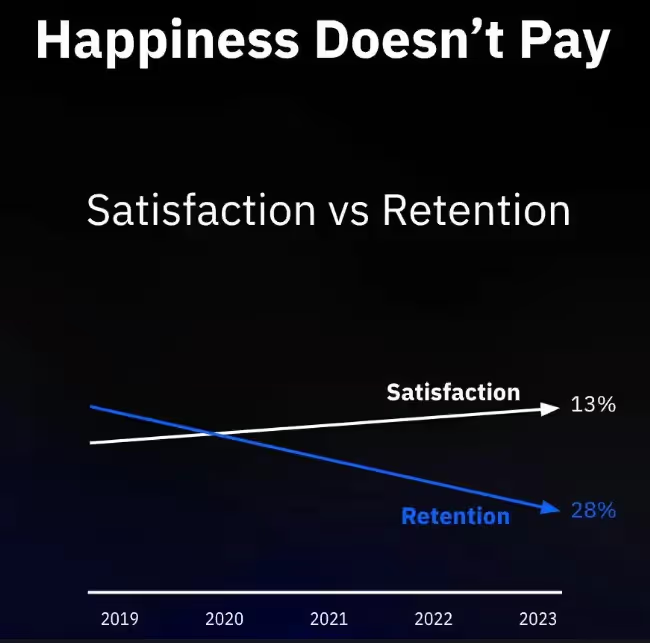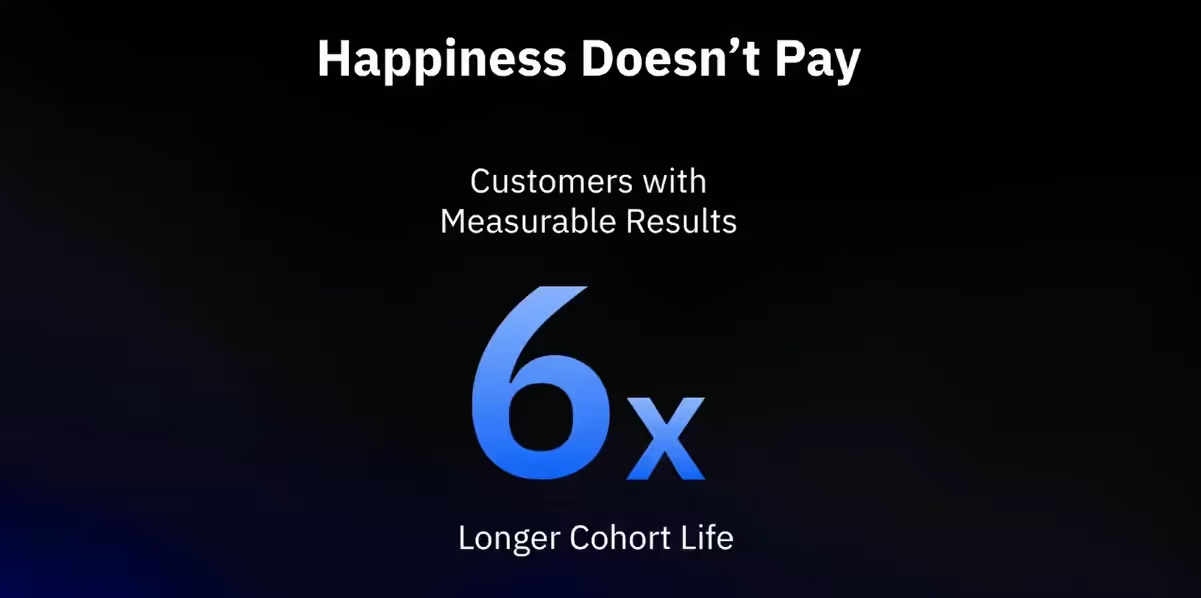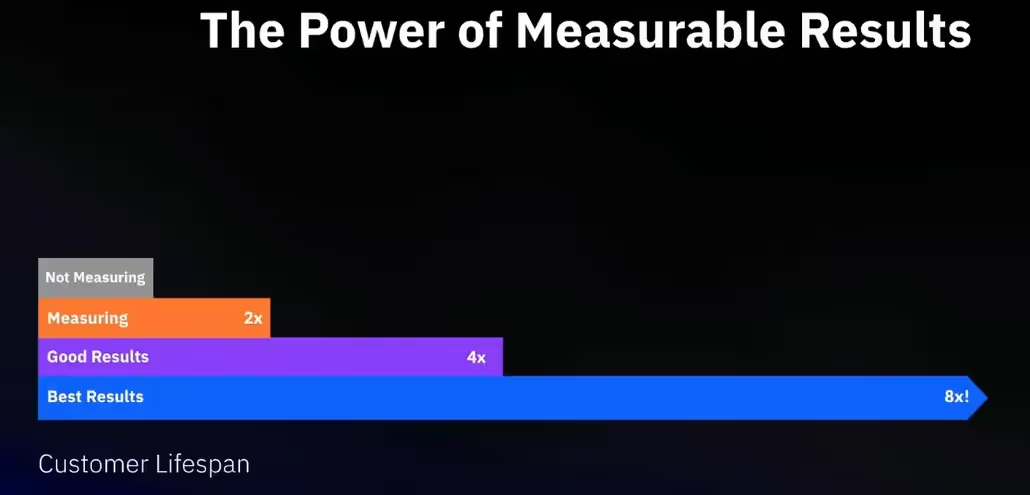If you work in implementation, onboarding, or professional services, you're familiar with the pressure of launching customers on time and delivering value fast. Customers are increasingly wary of investing in software that ends up as "shelfware." Delays in realizing value can lead to uncomfortable conversations and, ultimately, disengagement.
In a recent Rocketlane webinar, Greg Daines, founder, and CEO of ChurnRX, spoke to Srikrishnan Ganesan, co-founder and CEO, Rocketlane to share research-backed insights on accelerating time to value—one of the key factors in reducing churn and driving long-term success. Here’s a quick summary of the key takeaways from the session.
Counterintuitive realities of customer success
ChurnRX’s research has revealed that much of what is believed about customer success doesn't always hold up in reality. For instance, it's common to hear from a customer who leaves despite claiming to have had a great experience. On the flip side, unhappy customers may continue renewing.
The traditional belief that happy customers stay, and unhappy ones leave, isn't universally true.

ChurnRX’s data-driven approach has provided fresh insights into what really drives customer retention. One key discovery: while companies have successfully improved customer satisfaction, retention rates have paradoxically declined over the same period.
Despite efforts to create better customer experiences, churn continues to increase.
Do happy customers stay longer?
ChurnRX set out to test the hypothesis that happy customers stay longer. A clear pattern emerged based on over two million records across B2B SaaS companies: customer satisfaction does not predict how long customers will remain with a company.

While ensuring customer happiness is important, it isn't the main driver of long-term success. The key lies elsewhere.
If not happiness, then what?
The most consistent finding from ChurnRX's research is that measurable results are the strongest predictor of customer retention. Customers who see tangible results tend to stay six times longer than those who don’t.

The power of measurable results in customer success
Even customers who see poor results tend to stay longer if their progress is being measured. It may seem counterintuitive, but simply tracking and communicating results, even when they're not ideal, can double the retention rate.
Data shows that customers who aren't measuring their results have the shortest lifespans.

Another striking finding is that customers who ultimately fail often experience early failures that go unnoticed. This underscores the critical importance of implementation.
Starting quickly and delivering early results have the most significant impact on long-term retention. Customers who get up and running within the first 10 days have a markedly higher retention rate compared to those who experience delays.

Customer success isn't just about creating happy customers—it's about delivering measurable results by accelerating time-to-value (TTV).
3 essential focus areas to accelerate TTV
Accelerating time-to-value isn’t an easy task, especially in complex environments with numerous dependencies. However, three key opportunities can significantly speed up results for the customer.
Here are three key approaches Greg recommends:
1. Implement results, not technology
Often, implementations are heavily technology-driven. This makes sense from a delivery perspective, but it overlooks the most important factor for customers: results. Customers stay with a product or service when they see measurable outcomes, not just a successfully installed piece of software.
To accelerate TTV, restructure implementation plans around customer success milestones, not just technical achievements. For example, breaking down complex implementations into achievable stages can provide early proof that the solution works. Customers don't need to wait for the entire implementation—they need to see evidence of value early on.
This isn't just about dividing the process into steps; it's about reordering them to deliver the quickest possible path to a result that matters to the customer. The goal is to prioritize the first measurable outcome, which may not be the ultimate goal but is enough to show they’re on the right track.
This approach doesn't require a complete overhaul—just a strategic rearrangement. Even in longer projects, reducing friction and providing early wins can transform the customer’s experience. While the first milestone may seem small, it can be the hardest for the customer to reach, and that initial success is key to driving long-term results.

2. Minimize customer dependencies
Variability in customer engagement and readiness can significantly slow down implementation. The key is to reduce customer dependencies that cause delays by streamlining processes and prioritizing essential tasks.
Here are the key strategies for minimizing customer-related variability and delays:
- Templatize and simplify early steps: Use templates to simplify complex tasks early on. For example, instead of guiding each customer through detailed setups, provide a default configuration that gets them started quickly. This approach reduces friction and accelerates progress.
- Defer non-essential and complex tasks: Push tasks that aren’t critical to later stages when the customer is more engaged and better equipped to handle complexity.
- Create lead time during the sales process: For tasks that are essential early on, engage the customer during the sales process to set expectations and prepare them for what's ahead.
- Offer flexibility for engaged customers: Not all customers are the same—some thrive on tackling complex configurations early, while others need a more simplified approach. Allow customers who are ready to dive deep into configurations early on the flexibility to do so. They are less likely to churn and more likely to become long-term success stories.
3. Hold customers accountable
The fundamental difference between customers who succeed and those who don’t is their willingness to change how they work to align with your product/solution.
Particularly in the enterprise space, where the complexity of implementations is undeniable, customers must adapt to new processes, systems, and ways of working to fully benefit from the solutions they’ve invested in.
To hold customers accountable, you need to:
- Lay down the expected actions and the commitment: Start by clearly defining the results that successful customers typically achieve. Then, outline the key actions they need to take to reach those results.
Use a well-crafted script with the appropriate prompts to secure your customers' commitment to making these necessary changes.

- Measure and revisit results: Regularly measure results and share them with your customers. If they’re not on track, have an honest conversation about what went wrong and how you can help them course-correct.
The right messaging can help you reinforce their commitments, reset expectations, and offer continued support to help them get back on track.

- Be on standby for support: Assume that customers need guidance and provide as much support as possible. This might include documentation, live assistance, or other resources to help them accomplish the key actions.
Engage with the appropriate authorities within the customer’s organization early on. Keep the leadership engaged to ensure you have access to the resources and decision-makers needed to resolve these blockers promptly.
- Engage the sponsor to drive accountability: At the kickoff meeting, ask the executive sponsor, “What should we do if your team falls behind?” Expect them to respond with instructions to escalate issues promptly. This establishes a protocol for addressing delays and ensures the sponsor is aware of potential issues early.
Prioritize setting up dashboards and tracking metrics from the start of the implementation. Even if data is not yet available, this approach demonstrates a commitment to delivering results and keeps the sponsor engaged.
Q&A on accelerating time-to-value with Greg Daines and Srikrishnan Ganesan
1. Are the results being measured customer-dependent or universal?
Greg: Surprisingly, universal. Here’s why: very few customers come with a carefully thought-out measurement plan, and when we review it, we often agree it’s valid and will work. We follow their guidance in those cases. However, if a customer presents a result that’s incorrect or not a good measure of value, we’ll need to correct it.
The most common situation is that customers don’t know how to measure results properly. The key is to build your process around standardized measurements, allowing for modifications from customers with the right ideas. This approach works because about 80% of customers may not have clear measurement criteria.
It’s about creating a consistent, standardized pathway to predefined results that deliver the best value. If customers have many different results they care about, start with the most universally applicable recommendation. This approach will work for a large number of your customers and allow for adjustments as they mature. Standardizing is the winning play here.
2. From your research findings, do you see any correlation between ROI, retention, and results?
Greg: We've tested dozens of variables to see if they correlate with retention, and most factors do, including customer size, origin, use case, discounts, and package choices. However, customer satisfaction is the only measure that doesn’t correlate with retention.
The strongest predictor of long-term retention is the results customers achieve. While various factors indicate potential outcomes, they ultimately affect or reflect the results. For example, customers with more negative experiences often stay longer than those with only positive experiences. This happens because engaged customers who face challenges are more likely to achieve good results, whereas those with fewer negative experiences may be less engaged.
Discounts also illustrate this point. Customers who get higher discounts tend to churn more. This is because discount-seeking customers are often less engaged or invested, and those who receive discounts may feel less committed. The underlying issue is that these factors impact the likelihood of achieving desired results.
Sri: To add to that, when customers ask for discounts, they often do so to avoid making a strong ROI case to their finance teams. This lack of commitment to demonstrating efficiency gains and other benefits means they might not fully invest in realizing those benefits, which can lead to failure.
3. Can you provide examples of low-touch or digital implementations following these principles?
Greg: The key is to standardize. Instead of customizing everything for each customer, which is often driven by a customer satisfaction mindset, focus on results. Reverse engineer how customers get results and create a standardized pathway.
One step is teaching them what results they can expect and what they need to do, minimizing friction. A lot of this can be automated. Although it's not always possible, we segment our customers to handle different levels of engagement. For customers at a more basic level, we can push a specific pathway that minimizes friction and maximizes results.
For many clients, we build a digital motion. This might be an email sequence or in-product prompts where customers choose one of a few key results they want to achieve, or just one. Then, they get their first task with clear instructions on how long it will take. Once they complete it, they get the next task. Automating this process becomes easier when the pathway is well-defined.
Sri: Examples that come to mind include Drift and Coupa. Drift shows results directly inside the product—like how many meetings were booked—so users don't need to go to a separate dashboard. Coupa does something similar by showing savings upfront within the product.
I recommend pulling out key result metrics and displaying them right in front of users before they get into the software. This approach is much more effective at helping them see value and keep motivation high.
4. Can these principles be applied post-implementation for measuring results in the steady state?
Yes. What we know is that the biggest leverage is early on, like during implementation or shortly after. But the same principle applies indefinitely. You need to find a regular cadence for showing customers their results. Doing that essentially eliminates the vast majority—90 plus percent—of issues going forward. It’s also the key to encouraging expansion and more engagement.
When you show customers results regularly, they become increasingly aware that your role is to drive results, not just to provide technology. They’ll start asking, "Could you help us with this?" or "Do you have a product for that?" This is powerful. I call it customer bonding.
Customer bonding happens when customers can no longer visualize their future success without you, your product, and your company. This is the most powerful type of customer loyalty. It’s about creating the expectation that your role is to deliver results and accelerate their success over an indefinite period. When customers see you in this way, it changes everything about their approach to your company.
5. What role do leadership and implementation teams play in keeping customers accountable?
Here’s what I found: My team was always doing excellent work and trying their hardest, but where we consistently fell short was in my role. The more I looked internally, the more I realized that what we needed was more process and specific clarity about what to do and prioritize. Prioritizing results was a significant shift.
We needed to shift from just aiming to make customers happy to focusing on making them successful. This shift in mindset changes everything. So, leadership must start by prioritizing results over mere satisfaction. Building clear processes and pathways is essential for teams to excel. When leaders establish these structures, it enables their teams to perform at their best.
{{demo}}



















